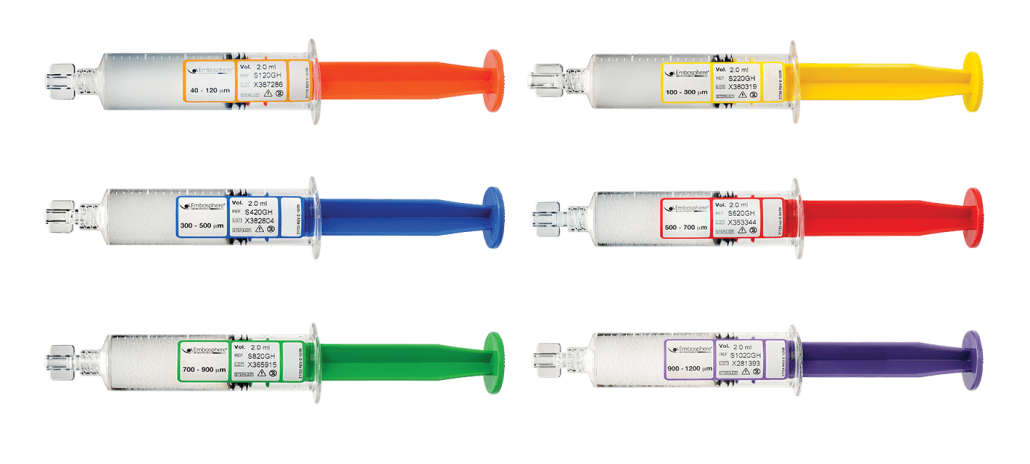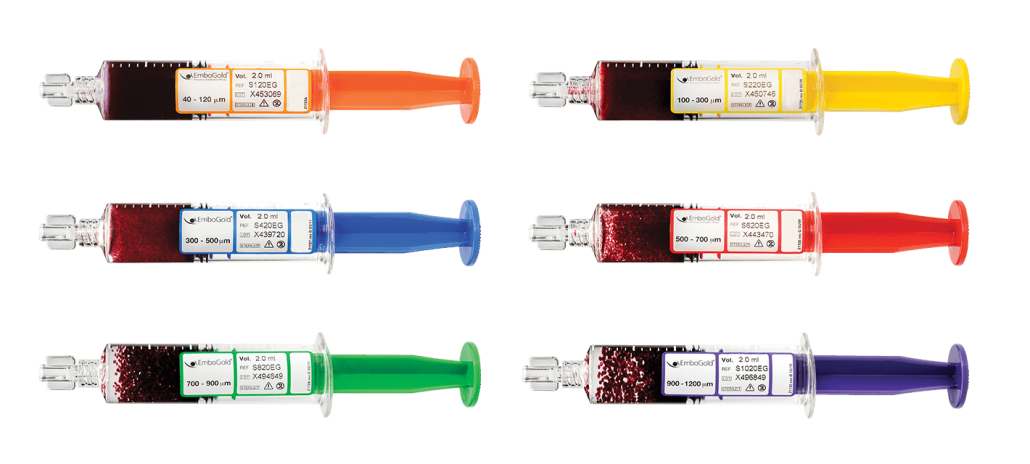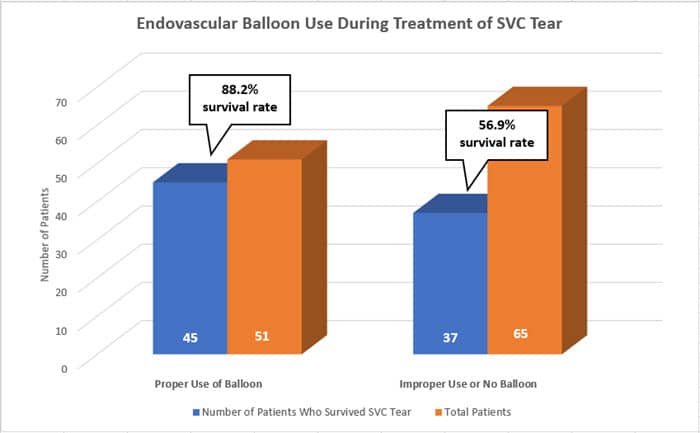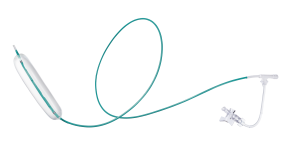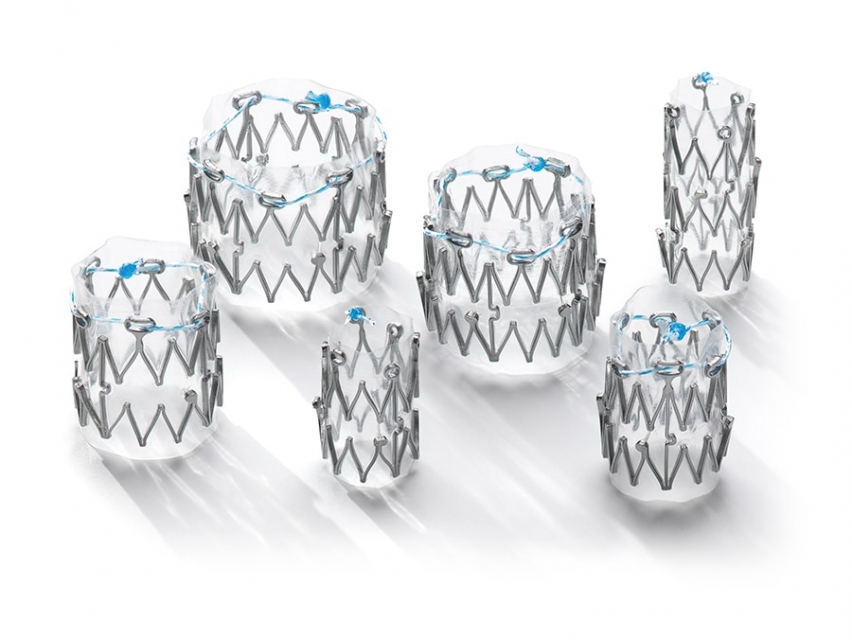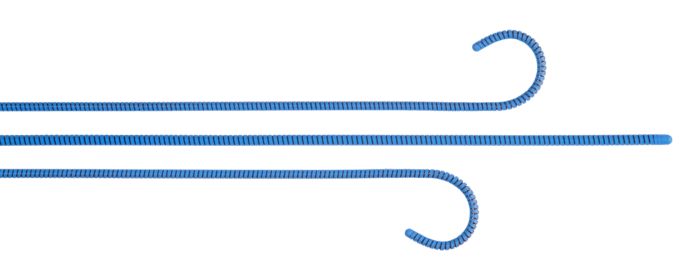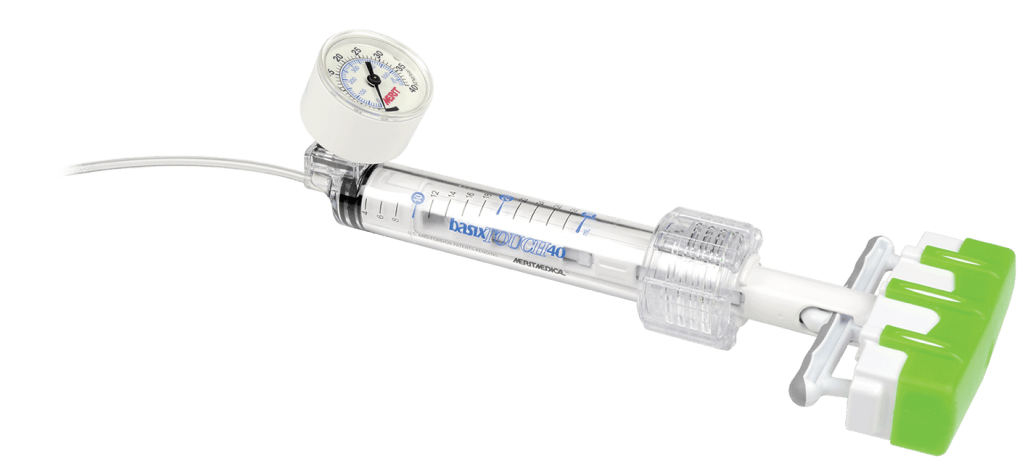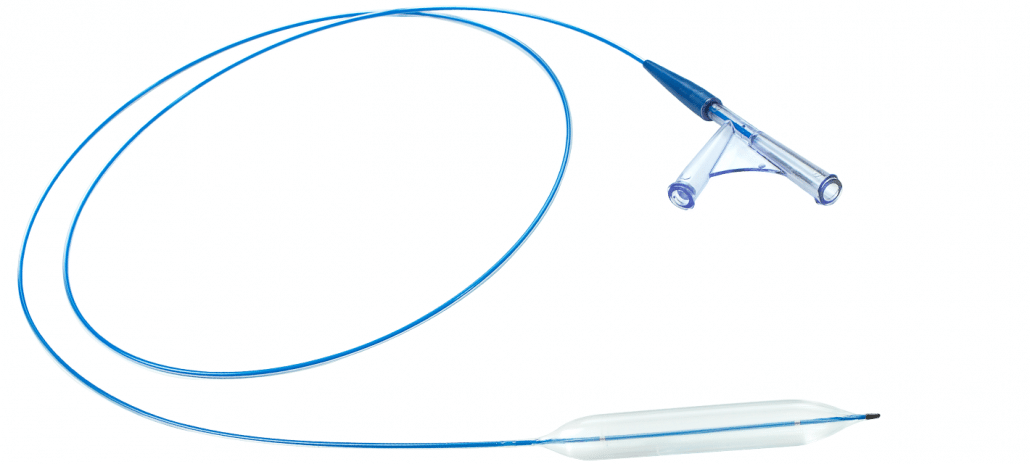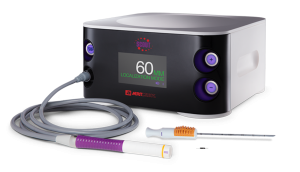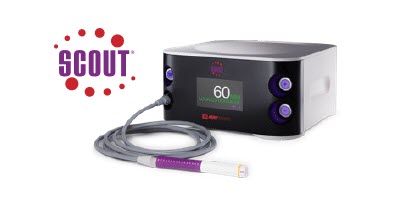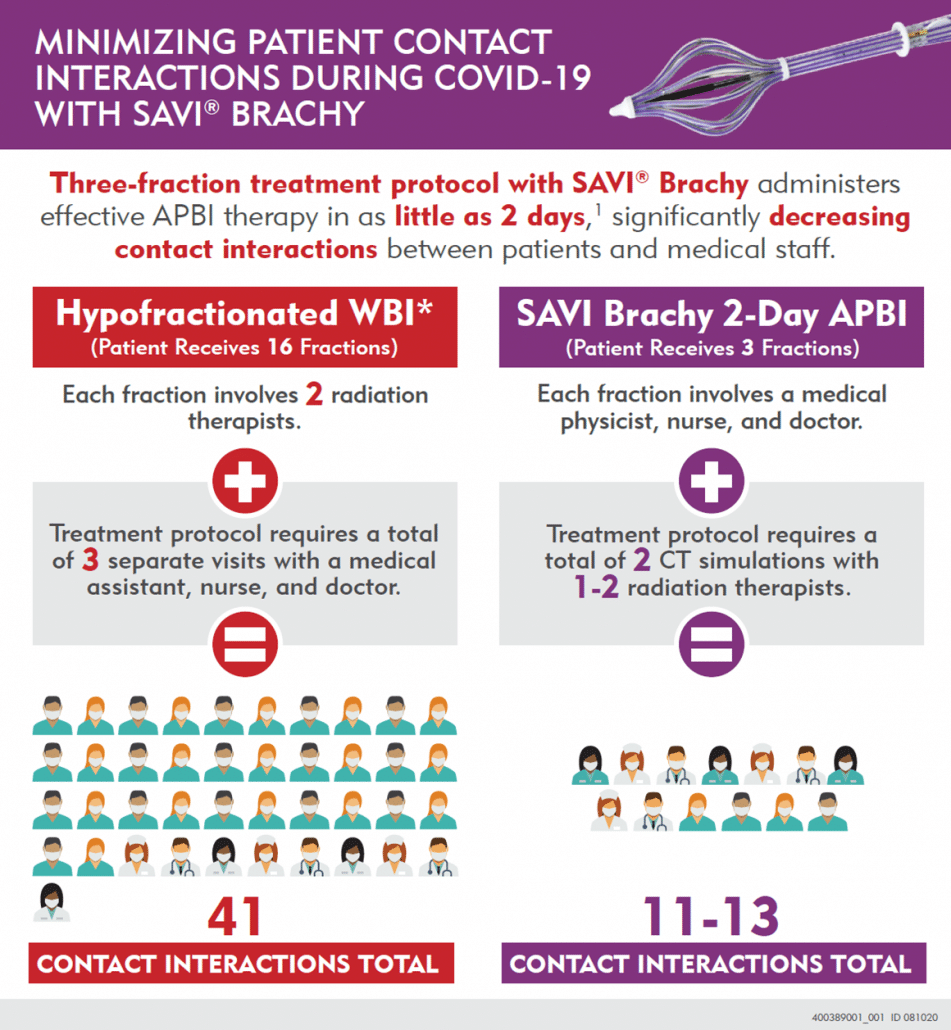SwiftNINJA® Overcomes Challenges of Selective Catheterization
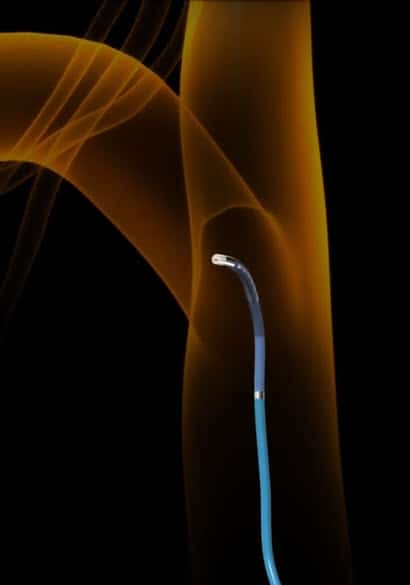
Selective catheterization can be associated with several challenges, such as acute angle branching, blood vessel tortuosity, and small targeted vessel diameter.1 The SwiftNINJA Steerable Microcatheter by Merit Medical, a straight tip catheter that articulates up to 180 degrees in opposing directions, is designed to rapidly select challenging vascular ostium.
A case report by Soyama et al.1 found multiple benefits to using the SwiftNINJA in catheterizations involving acute angle branches as well as a new technique of intentional folding of embolization coils for compact coil packing. The authors found that using a steerable microcatheter made the procedure easier compared to using a conventional device.
The study, published in CardioVascular and Interventional Radiology,1 discussed the following two cases:
CASE 1: CATHETERIZATION OF ACUTE ANGLE BRANCHES
A male patient in his 60s presented with an angiomyolipoma of the left kidney. CT images showed an 8-cm tumor of the left kidney, which had enlarged. To prevent tumor rupture, transcatheter arterial embolization was conducted.
Using the Seldinger technique, a 5F J-shaped sheath introducer was placed percutaneously into the aorta via the left femoral artery. Selective left renal arteriography was performed with a 4F cobra-shaped catheter.
The arteriogram showed two arterial branches of the superior renal capsular artery supplying the primary blood flow to the tumor, both branching out from the main left renal artery with an acute angle of origin. Due to the acute angle branching, Soyama and his team were unable to selectively insert a manually tip-shaped guide wire and instead used the SwiftNINJA as follows:
Bent the tip to turn the orifice of the targeted branch by dial manipulation at the proximal handgrip. Fixed the shape of the tip with the dial stopper.
STEP 2:
Inserted a 0.016-in guide wire into the targeted branch.
STEP 3:
Unlocked the dial stopper. Pushed the microcatheter deep into the targeted branch using the over-the-wire method.
RESULTS:
Catheterization of two targeted branches was completed within 3 minutes. Successful embolization of the target branches followed.
CASE 2: INTENTIONAL FOLDING OF METALLIC COILS IN THE BLOOD VESSEL
A male patient in his 60s presented with right maxillary cancer and was admitted for transcatheter arterial infusion chemotherapy combined with irradiation.
A 5F sheath introducer was percutaneously placed into the aorta via the right femoral artery followed by selective insertion of a 5F catheter into the right common carotid artery. The SwiftNINJA was then inserted into the right internal and external carotid artery.
Selective angiogram showed the targeted tumor was being supplied by the right internal maxillary artery, the transverse facial artery, and the facial artery. It was embolized with pushable metal coils with the intention of creating compact packing of the coils to strengthen the embolic effect and prevent reperfusion:
STEP 1:
Bent the tip of the SwiftNINJA inside the blood vessel using the proximal dial, maintained tip shape, and slowly pushed the coil. The coil was intentionally folded by the change in tip direction. Compact packing was achieved.
STEP 2:
Pushed the second coil into the targeted blood vessel in the same way, completing the embolization using compact coil packing of the right superficial temporal artery.
In procedures such as these, selective catheterization can be very difficult, in some cases forcing a physician to abandon the catheterization all together—even if the shape of the guide wire and catheter was chosen to fit a desired vessel branch.1
In contrast, the SwiftNINJA “has the potential to make selective catheterization easier than when using the conventional device, due to the ability to control the tip shape,” the authors write.1
In the first case,1 the SwiftNINJA allowed the user to shape the tip to the targeted branches easily and properly when needed. It could also be manipulated during catheterization without removing it to reshape the tip, which the authors said could potentially make selective catheterization easier.
The authors1 suggested that in the second case, the SwiftNINJA could be useful for both selective catheterization and compact packing of metallic coils where adjusting and maintaining microcatheter tip shape can be a challenge. Using a steerable microcatheter, they write, “enables the user to easily create an initial loop of the inserted coil and intentionally fold the coils with the stiffly bent catheter tip.”
Soyama et al.1 concluded that the SwiftNINJA “has the potential . . . to allow difficult catheterizations to be completed more easily.”1
SWIFTNINJA KEY FEATURES
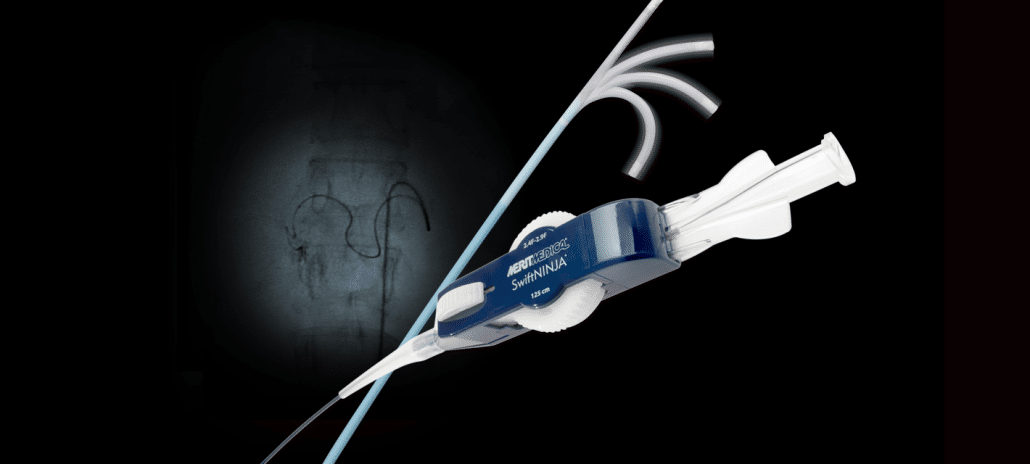
Several features and benefits enable the SwiftNINJA to be the solution needed during challenging interventional procedures:180-Degree Steerable Tip The SwiftNINJA’s steerable tip provides speed, navigation, and support—even in the most challenging vascular anatomy. An ergonomic steering dial enables the catheter tip to be deflected from straight to opposing directions up to 180 degrees, allowing for in vivo steering control.
Steering Lock Once the SwiftNINJA’s tip is positioned at a desired location, it can be locked to hold the shape of that position. The tip will remain positioned for embolic placement without the worry of recoil, loss of position, or embolic displacement.
Multi-Dimensional Steering Once the catheter is shaped into a desired position, the SwiftNINJA can then be torqued and advanced through the vasculature, providing 3D steering as it moves in two planes simultaneously.
Tungsten-Braided Shaft Built with a tungsten-braided shaft, the SwiftNINJA provides support and pushability when navigating tortuous vasculature.
Cost Efficiency Because the SwiftNINJA can navigate through complex blood vessels and reach target anatomy quickly, it can be a cost-effective option compared to failed attempts using numerous catheters. As mentioned by Soyama et al.,1 the SwiftNINJA made their procedure easier to perform than using a conventional device.
Similarly, another case study by Hinrichs et al.2 described successful coil embolization of a small hepatointestinal collateral with the SwiftNINJA after failed attempts with other catheters. Henrichs et al.2 write, “taking into account the numerous regular microcatheters that were used without success in our two cases, the appropriate use of a steerable microcatheter can be even more cost-effective with regard to the total material costs.” Merit Medical is committed to providing the medical devices needed to improve and transform healthcare. Discover the SwiftNINJA Steerable Microcatheter by visiting the product page and the Merit Medical Customer Support Center for more information.
RELATED PRODUCTS
References
1. Soyama et al. 2017. “The Steerable Microcatheter: A New Device for Selective Catheterization,” CardioVascular and Interventional Radiology 40, no. 6: 947-952, PMID: 28138724.
2. Hinrichs et al. 2017. “Coil Embolization of Reversed-Curve Hepatointestinal Collaterals in Radioembolization: Potential Solutions for a Challenging Task,” Radiology Case Reports 12, no. 3: 529-533, PMID: 28828119.
Looking for a Career Change? Your Experience Is Valued at Merit—Here’s Why.
As a leader in the healthcare industry, Merit Medical employs innovative and dedicated people across the globe. Here, we offer more than just a job. This is a place to make a difference, form friendships, and build a career. While always looking for employees at all levels of experience, Merit is actively recruiting seasoned workers who want more from their current job. With a host of benefits and an incredible employee culture, Merit is an excellent choice for individuals looking to shake up their work life. Considering a change in your career path? Here are the top four reasons why Merit is the place for you.

EXCELLENT BENEFITS PACKAGE
“Employee benefit plans are consistently polled as being one of the most important aspects of a job, and Merit provides some of the best in the business,” says Rick Portrey, Director of Recruiting and Employment at Merit. “We offer competitive pay with an anticipated pay increase in the coming weeks, as well as paid vacation and an employee stock program to help strengthen your investment portfolio.” Merit’s health benefits are bolstered by other unique offers, such as an on-site clinic at the Salt Lake City Global Headquarters, which provides excellent healthcare and major savings in medical expenses for employees and their family members.
SHIFT STABILITY
Maybe you’re coming from a job with a rotating schedule, and you’re looking for something more consistent. Perhaps you need the stability of a guaranteed number of hours each week, with the possibility of overtime. Or you might need an early shift that will free up your afternoons to run errands or pick up the kids from school. Whatever the reason, Merit’s shift stability is why employees love working here. “We offer a variety of shifts to choose from, so you can work the hours that are best for your schedule,” Portrey explains. Shifts are consistent week to week, providing a guaranteed number of hours, so employees can plan better. Putting it best, Portrey adds, “We want to accommodate many situations, including people with families to care for, which is why we offer the schedules we do. With shifts starting as early as 4:30 AM, or shifts that run Monday through Thursday, we show that we want to work with your schedule, not against it.” Merit knows that family matters. Helping employees and their families thrive is an important part of the company-wide culture.
YOUR WORK WILL ALWAYS BE MEANINGFUL
“Merit products help improve the lives of over 15,000 patients per day,” Portrey says. When you work at Merit, you’re actively making a difference in your community. The essential medical devices you help to manufacture, assemble, and distribute will be used all over the world. Merit employees get to see firsthand the impact they make and the lives they change. In addition, a multitude of career development opportunities are offered, showing that from day one the whole team wants you to succeed. Merit employees thrive in a professional work environment where productivity and growth are valued.
YOU BELONG
“People make friends here,” Portrey continues. “We try to ensure that our employees never feel alone while working at Merit, whether it’s day one or day two thousand. Our staff is the friendliest around. Here employees hold doors open for each other and say ‘hello’ in the halls.” At Merit, it’s common for everyone to look for opportunities to help and build each other up through unwavering support. Employees value integrity and dedication, and that comes from a foundation of mutual respect for everyone. When you join the Merit family, you’ll see the Merit difference. Careers begin here. If you’re searching for a change in your professional life, find a job on our current openings page and start your application today. “Merit is more than just a workplace,” Portrey says. “It’s a family and a community. It’s a culture.”
Arcadia™ Steerable Technology Provides Unique Benefits to Vertebral Augmentation Treatment
Vertebral compression fractures (VCFs) are the most common fracture in patients with osteoporosis.1 Although painful and debilitating, VCFs often go untreated. To help care for this patient population, Merit Medical innovated the Arcadia, an intuitive balloon-assisted vertebral augmentation (kyphoplasty) system. Designed to be used with the steerable PowerCURVE® Navigating Osteotome, the Arcadia offers several unique benefits when treating patients with painful VCFs.
Bipedicular Footprint, Unipedicular Approach
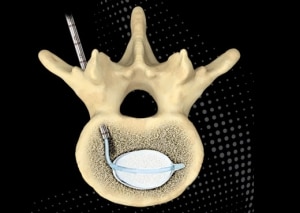
Steerability allows the Arcadia system to target a specific location within the vertebra using a transpedicular approach through a single skin incision. Once past the pedicle body junction, the ability to articulate the device allows accurate navigation to the biomechanically critical important anterior and middle third of the vertebra, resulting in a bipedicular cement footprint byway of a less invasive unipedicular approach.
Unipedicular access has other clinical advantages as well. A systematic review and meta-analysis published in Pain Physician2 compared the safety and efficacy of unipedicular and bipedicular vertebral augmentation approaches in the treatment of osteoporotic VCFs. Results showed that the unipedicular approach required less procedural time, lower radiation dose, and a reduced cement leakage ratio with similar clinical outcomes in pain relief, decreased disability, and improved short and long-term general health.
Reduced Procedural Radiation Exposure
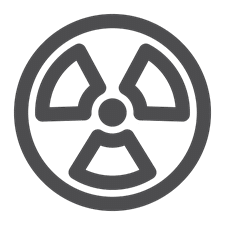
The use of fluoroscopic guidance in the transpedicular treatment of VCFs is necessary for visualization; however, radiation exposure must be limited when possible. The single access unipedicular approach, as provided with the steerable Arcadia, has the potential to reduce radiation exposure.2 Radiation exposure to patients undergoing unilateral vertebral augmentation has been shown to be 50% of the dose received by patients who receive bilateral treatment.2
Safe Transpedicular Access

Transpedicular steerable access, as made possible with the Arcadia and the PowerCURVE, is intended to enable safe passage past the pedicle body junction into the vertebral body. This approach offers advantages, including avoidance of the radicular spinal arteries, which are vulnerable when using an extrapedicular approach. This is significant given spinal arteries, such as the artery of Adamkiewicz, usually arise from the level of the ninth intercostal artery to the second lumbar artery.3
Further, Liu et al. reported that extrapedicular vertebral augmentation in the lumbar vertebrae had a risk of injuring the lumbar artery and was not recommended for use in L4 and L5, especially in female patients.4 Given this data and the size of lumbar vertebrae, transpedicular access with the steerable Arcadia and PowerCURVE devices may be an appropriate treatment option for this patient population.
Transpedicular access through the pedicle using steerable devices also reduces the oblique angle required when using rigid straight devices, decreasing the risk of breaching the medial cortex and cement leakage within the spinal canal.5
Enhanced Navigation

Compared to curved devices manufactured with a predetermined shape which limits trajectory based solely on access into the vertebral body, steerability allows physicians to change trajectory simply by turning the gray handle of the PowerCURVE and Arcadia after accessing the vertebra.
This provides a targeted single-access ability to cross the vertebral midline, enabling optimal balloon tamp positioning and cavity creation. The steerable osteotome, when used alone, can provide targeted channel creation, simultaneously sparing healthy cancellous bone and maximizing surface area to facilitate cement interdigitation. In addition, targeted cavity creation supports the controlled delivery of high-viscosity cement with optimal cement fill.
Reduced Complications

The sophisticated steerable technology of the Arcadia system enables a unipedicular approach to treatment. Complications associated with vertebral augmentation, in general, include infection, neural damage, and pedicle fracture.6 Passing the spinal canal only once, as seen with a unipedicular approach, may reduce the occurrence of such complications.
The Arcadia Balloon-Assisted Vertebral Augmentation System is a prime example of the new technologies Merit provides physicians, helping them to improve procedural outcomes and better the patient experience.
Explore the Arcadia by visiting its product page or through the Merit Customer Support Center.
References
- Pilitsis JG. n.d. “Vertebral Compression Fractures.” https://www.aans.org/en/Patients/Neurosurgical-Conditions-and-Treatments/Vertebral-Compression-Fractures.
- Sun H et al. 2016. “Can Unilateral Kyphoplasty Replace Bilateral Kyphoplasty in Treatment of Osteoporotic Vertebral Compression Fractures? A Systematic Review and Meta-Analysis.” Pain Physician 19, no. 8 (Nov–Dec): 551–563. PMID: 27906934.
- Kudo K et al. 2003. “Anterior Spinal Artery and Artery of Adamkiewicz Detected by Using Multi-Detector Row CT.” American Journal of Neuroradiology 24(1): 13–17. PMID: 12533320.
- Liu L et al. 2019. “An Anatomical study on lumbar arteries related to the extrapedicular approach applied during lumbar PVP (PKP).” PLoS One 14, no. 3: e0213164. PMID: 30835754.
- Chung HJ et al. 2008. “Comparative Study of Balloon Kyphoplasty with Unilateral Versus Bilateral Approach in Osteoporotic Vertebral Fractures.” Int Orthop 32, no. 6 (Dec): 817–820. PMID: 17768624.
- Tsoumakidou G et al. 2017. “CIRSE Guidelines on Percutaneous Vertebral Augmentation.” Cardiovascular and Interventional Radiology 40(3): 331–342. PMID: 28105496.
Merit’s Journey Through COVID-19: A Video Series
For more than thirty years, Merit Medical® has made it a priority to deliver life-changing products and services, all while ensuring the safety of employees, customers, and patients.
THIS TIME IS NO DIFFERENT.
The COVID-19 pandemic is without a doubt an unprecedented time in the history of healthcare, but it is also one that has provided a valuable opportunity to evolve and discover new ways to meet the diverse needs of healthcare providers and patients.
To share our step-by-step response to COVID-19, the Merit team has created a series of videos, each providing an in-depth look at important topics, such as how employees are protected during the pandemic, how each global facility maintains a safe work environment, how we are adapting to new customer protocols, and how numerous virtual initiatives have been implemented to provide seamless customer support. All of this and more is done every day to ensure Merit products and services are made available, especially to the frontline healthcare professionals and patients who need them.
As more videos are added in the coming months, we encourage you to check back and experience our journey with us as we navigate through the COVID-19 pandemic.
Endovascular Balloon Use Increases Survival in Patients with SVC Tears
Superior vena cava (SVC) tears are one of the most-deadly complications in transvenous lead extraction procedures. Although rare, occurring at 0.46% of all lead extractions performed, more than half of these SVC tears end in mortality.1 A multi-year analysis published in Circulation: Arrhythmia and Electrophysiology, showed that when an endovascular balloon was used, patients undergoing lead extraction were more likely to survive.1
Transvenous lead extraction is considered safe and effective with a low major complication rate.1 However, complications can occur—one being the dangerous and often lethal SVC tear. In such situations, an endovascular balloon is used to occlude the SVC tear, preventing blood loss and offering more time for repair.
Azarrafyi et al.1 collected data on adverse events in lead extraction between July 1, 2016, and July 31, 2018. SVC tears were examined for patient demographics, case details, and index hospitalization mortality.
Results1 showed 116 confirmed SVC events. Out of these, 44% involved proper endovascular balloon use, and 56% did not use a balloon or had improper use of one. Proper use of an endovascular balloon led to 45 of 51 patients (88.2%) surviving in comparison to 37 of 65 patients (56.9%) where a balloon was not used or was improperly used (P=0.0002). Proper balloon deployment was an independent, negative predictor of in-hospital mortality for patients who experienced an SVC tear (odds ratio, 0.13; 95% CI, 0.04–0.40; P<0.001).
The authors of the study concluded that patients undergoing lead extraction were more likely to survive SVC tears when treatment included an endovascular balloon.1
To care for patients with SVC tears, Merit Medical offers the Vitale™, an occlusion balloon that maintains hemostasis for up to 30 minutes,2 intended to allow time for patients to stabilize and transition to surgery.
Clinician evaluations3 comparing the 8F and 10F Vitale with a competing endovascular balloon showed the Vitale to have a faster placement time of 30 seconds (1:28 vs. 1:58). Clinicians also reported the Vitale 8F and 10F to have softer tips that are less traumatic to the vasculature.
Additional benefits of the Vitale Occlusion Balloon:
- Faster Inflation4 Ensures any tear is occluded promptly.
- Smallest Footprint on the Market 8F has same capabilities as a larger balloon.
To further prep clinicians for procedures, Merit offers the Vitale in a premier kit, conveniently providing the tools needed for SVC treatment.
| Kit Contents, 8F Balloon | Kit Contents, 10F Balloon |
|---|---|
| 60 cc VacLok® Syringe | 60 cc VacLok® Syringe |
| 8F Prelude SNAP™ Hydrophilic Sheath Kit | 6F Prelude SNAP™ Hydrophilic Sheath Kit |
| InQwire® Amplatz Guidewire 0.035″ X 260 cm 3 mm J Tip | 10F Prelude SNAP™ Hydrophilic Sheath Kit |
| InQwire® Amplatz Guidewire 0.035″ X 260 cm 3 mm J Tip |
Discover the Vitale Occlusion Balloon by visiting the product page and contacting Customer Support for more information.
Because when it comes to SVC tears, every second counts.
References
- Azarrafyi et al. 2019. “Endovascular Occlusion Balloon for Treatment of Superior Vena Cava Tears During Transvenous Lead Extraction: A Multiyear Analysis and an Update to Best Practice Protocol.” Circulation: Arrhythmia and Electrophysiology 12(8): e007266. PMID: 31401856.
- Data on File.
- Clinician Evaluations, Final Report. Data on File.
- Data on File.
Secrets to Success: How to Apply at Merit—and Land the Job

Merit Medical is known for its strong employee culture. With thousands of employees worldwide, a broad range of excellent benefits offered, and a workday that always ends in making a difference—it’s easy to see that a career with Merit is both a rewarding and valuable opportunity.
You’re ready to become part of the Merit Team, but how can you stand out from other applicants? We sat down with Rick Portrey, Director of Recruiting and Employment at Merit, to discuss what he looks for in the hiring process. Each week Portrey reviews several applications. Here’s what he says are the secrets to success when applying for a job at Merit.
1. Aside from technical qualifications, what do you look for in an applicant?
We first look for the very basics, such as a strong work ethic, someone who takes pride in his or her work, and someone punctual. We also look for someone who can be teachable. A lot of times people don’t understand that being teachable is just as important as the technical qualifications we require.

2. What do you think the most important quality is in an applicant?
Aside from a willingness to work, applicants must have a positive attitude. At Merit, you’ll be working alongside people day in and day out, finding solutions to healthcare challenges. It’s important to be able to get along with others, help each other out, and learn from each other. That’s when productivity is at its best.
3. What makes a resume stand out?
A thorough chronological resume is always a great start! Show us where you’ve been and what you’ve been doing. Tell us about the experience you’ve gained and the skills you learned along the way. What has your path been? If there are gaps, don’t be afraid to explain them.
Make it easy for the Merit recruiters or hiring managers to review your resume to see why we should hire you. You have 30 seconds for a recruiter to review your resume—but I’ll be honest, it’s usually closer to 10–15 seconds when looking at multiple resumes. If it’s a confusing resume, it’s not going to get a great look. You want to distinguish yourself with a clean, easy-to-read, easy-to-digest resume.

4. What sort of experience would be useful as a Merit employee?
It depends on each position, but primarily we’re looking for people who know how to work, who want to work, and who want to make a difference. Anywhere you can show how your experience will make you an asset at Merit, that’s what we look for in a resume.
For example, say you work at a fast-food restaurant, but you’re looking for something with more stable hours in manufacturing. You may not think of it this way, but fast food is a type of assembly line. You have to assemble and package orders accurately and quickly. If you apply for one of our entry-level operations positions, that type of experience would translate well to the work you would do at Merit.
5. How can an applicant prepare for an interview?

Research. Know who the company is. Know what we do at Merit. Know the job you’re applying for. Watch videos on our site. Understand what the hours are and make sure they work for you. Researching and understanding the company and the position will distinguish a person better than anything else because a lot of the time, the other candidates haven’t done much research.
Another tip is to ask relevant questions to the interviewer. You could ask: “In your experience, what makes a great Merit employee?” or “How would my performance be evaluated?” This would show the recruiter that you’re thorough and interested in the position.
6. How could an applicant go the “extra mile” in an interview?
It’s impressive to hear candidates relate themselves to the position. If they ask, “What would my expectations be in my first week or month at Merit?” it shows us that they’re thinking ahead and picturing themselves in the position. One question I’ve always liked to ask an interviewer is, “Why do you like to work at Merit?” This question personalizes the interview and shows genuine interest in the interviewer. Many times, this question gives additional insight into the position and company that didn’t come out in any other part of the interview.
7. What aspects of Merit’s employee culture make us a great company to work for?
There are many things we love about Merit. One, in particular, is that people make friends here. For example, a Merit security guard once mentioned to me that we’re the nicest company he has ever worked for—and this is someone who has worked for many companies. People hold doors open for each other, and they greet you in the halls. They genuinely look out for each other.

Another perk is that Merit takes care of employees. Benefits depend on location, but for example, at our Global Headquarters in Salt Lake City, which is one of our largest facilities, we have an on-site employee health clinic, a benefit that results in huge medical savings.
We also have an employee garden designed to help our team members be the healthiest they can be by providing fresh produce and a bit of nature in their workday.
In addition, we have multiple shifts that people can choose from. Merit is a family-friendly company that understands the importance of flexibility. We want to help employees create a personalized path to success.
Ready to apply? Jump-start your career at Merit by browsing our current openings. We’re excited to work with you!
Lessons from A Specialty Surgery Division at the Pandemic Epicenter
In March 2020, following a national emergency declaration, New York City was an epicenter of COVID-19. At Columbia University Medical Center, one department’s adaptive response “Reporting for Duty: Lessons from A Specialty Surgery Division at the Pandemic Epicenter,” was recently published in the Annals of Surgery.
The disruption to normal hospital operations was unprecedented and immediately posed two challenges: managing existing hospitalizations and a massive influx of COVID-19 patients. A third challenge emerged: caring for patients who were scheduled for surgeries that would inevitably be delayed.
The specialty surgery division implemented a rapid response strategy for breast surgical patient management with the SCOUT® Radar Localization System. SCOUT enabled the division to triage patients and prepare for downstream radiology backlogs, effectively managing the myriad of unprecedented challenges that COVID-19 imposed.
Highlights from the Annals of Surgery article include:
- Postponement of screening mammography enabled radiologists to perform SCOUT localizations to minimize downstream scheduling obstacles for surgical patients.
- SCOUT reflectors were placed, up to 10 localizations a day to prepare for surgical intervention. This approach allowed for flexibility with an operative schedule that was unpredictable. Localized patients could be added to the surgery schedule immediately if the Surgical and Procedural Scheduling Committee’s approval was obtained. Columbia University Medical Center did not need to default to wire localizations during the height of COVID management.
Recognizing Lung Cancer Awareness Month
November is Lung Cancer Awareness Month, an important time for us at Merit Medical. As a patient-centric healthcare company, it is our goal to not only provide the tools physicians need to treat and improve outcomes for lung cancer patients but also to share knowledge and increase awareness surrounding the disease.
WHAT IS LUNG CANCER?
Lung cancer is a type of cancer that begins in the lungs. It is the leading cause of cancer deaths worldwide.1 Among women in the US, it has surpassed breast cancer, becoming the leading cause of cancer deaths nationally.2
There are different kinds of lung cancer, but the two main types are non-small cell lung cancer (NSCLC) and small cell lung cancer (SCLC).3
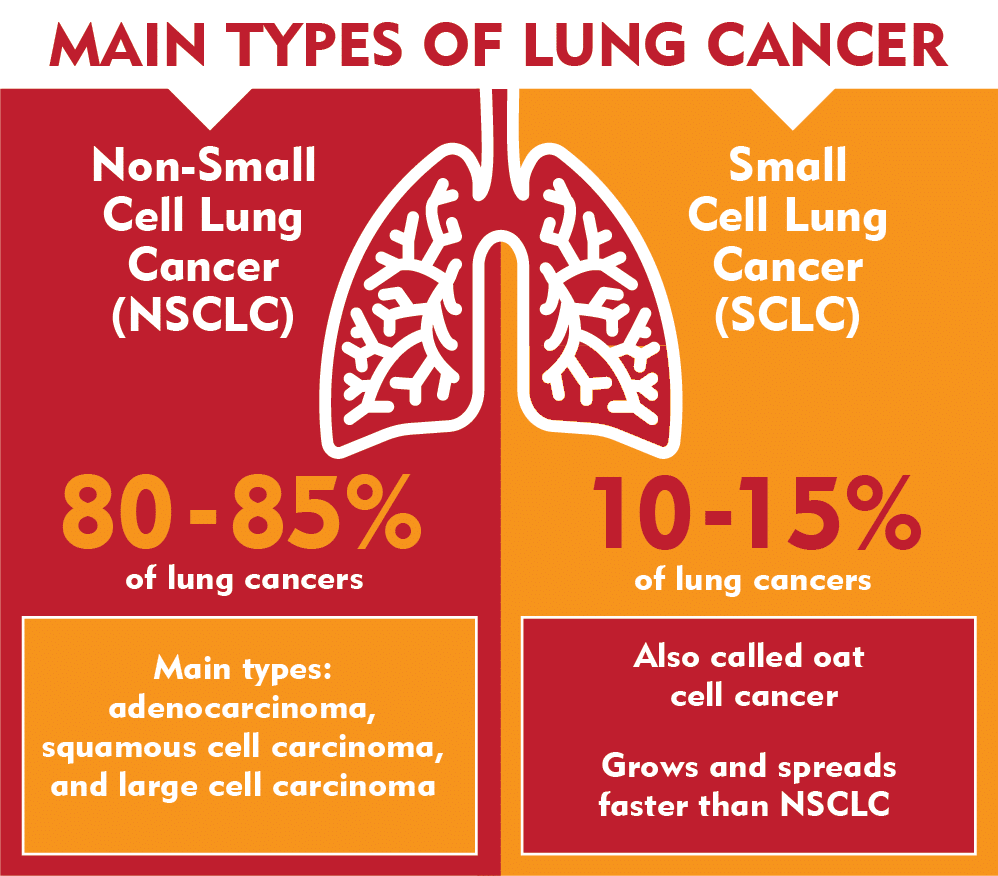
Learn more about NSCLC, SCLC, and other types of lung tumors here.
WHAT CAUSES LUNG CANCER?
It is unknown what causes every case of lung cancer, but there are known risk factors.
SMOKING4

Smoking is the leading cause of lung cancer, resulting in about 80% of lung cancer deaths. Although smoking is the strongest risk factor, it can also interact with other factors or not be the cause at all.
CAUSES IN NON-SMOKERS1,4

Many people who develop lung cancer are smokers or former smokers, whereas others have never smoked at all. Lung cancer in non-smokers can be caused by exposure to different substances, such as radon, secondhand smoke, air pollution, asbestos, diesel exhaust, and other chemicals. People with a family history of lung cancer are also at an increased risk.
A small percentage of people develop lung cancer who have no known risk factors. This may happen with no outside cause or may be due to factors we have not found yet.
Learn more about lung cancer risk factors as well as gene changes that may lead to the disease.
SYMPTOMS OF LUNG CANCER
In the early stages, lung cancer typically does not cause any signs and symptoms. In the advanced stages, common signs and symptoms of lung cancer can include:
- A new, persistent cough
- New onset of wheezing
- Coughing up blood or rust-colored phlegm
- Shortness of breath
- Chest pain, especially when breathing deeply, laughing, or coughing
- Hoarse voice
- Weight loss without trying
- Loss of appetite
- Fatigue
- Fluid in the chest
- Persistent infections, such as bronchitis and pneumonia
- Cancer spreading to other parts of the body (This can cause other signs and symptoms, such as headache, nausea, pain, etc., depending on which organ is affected.)
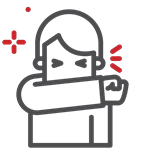
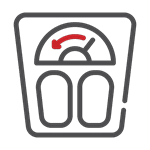
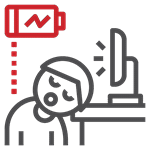
LUNG CANCER PREVENTION
Although lung cancer cannot always be avoided, steps can be taken to reduce your risk1.

Quit Smoking (or Don’t Start)
If you have never smoked, don’t start. If you want to quit, there are many replacement products, support programs, and medications available to help. Talk to your doctor.
Stay Away from Secondhand Smoke
Avoid places where people smoke. If you live with a smoker, encourage him or her to quit and ask that smoking be done outside.
Test Your Home for Radon
IIf you learn that you have high radon levels in your home, it can be corrected. Contact your local department of public health for more information.

Avoid Cancer-Causing Chemicals
Always follow precautions in the workplace to avoid toxic chemical exposure. If you work regularly in a hazardous environment, talk with your doctor to see what else you can do to protect yourself.

Live a Healthy Lifestyle
Choose a diet full of fruits and vegetables. Always choose nutritious foods versus taking large doses of vitamins, as some vitamins have been found to increase the risk of lung cancer.6 Include physical activity in your routine. Find a type of exercise you enjoy and try to be active most days of the week.
WHEN TO SEE A DOCTOR
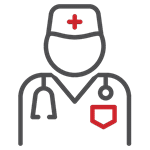
If you notice any signs or symptoms that worry you, make an appointment with your doctor. If you need help quitting, your doctor can create a care plan that may include medication, counseling, support groups, online resources, and replacement products.
Only 16% of lung cancer cases are diagnosed at an early stage, and more than half of people with lung cancer die within one year of diagnosis.2 If you are at an increased risk of lung cancer, talk to your doctor about lung cancer screening options. Early detection can make a difference. The five-year survival rate for lung cancer is 56% for cases detected when the disease is still localized within the lungs.2 However, these rates decrease dramatically to only 5% when tumors have spread to other organs.2
At Merit, our goal is to help people worldwide live their best lives. Learn about the trusted interventional and palliative treatment alternatives we offer.
RELATED PRODUCTS
References
- Mayo Clinic. “Lung Cancer Symptoms and Causes.” Accessed October 23, 2020. https://www.mayoclinic.org/diseases-conditions/lung-cancer/symptoms-causes/syc-20374620
- American Lung Cancer Association. “Lung Cancer Fact Sheet.” Accessed October 27, 2020. https://www.lung.org/lung-health-diseases/lung-disease-lookup/lung-cancer/resource-library/lung-cancer-fact-sheet
- American Cancer Society. “What Is Lung Cancer?” Accessed October 23, 2020. https://www.cancer.org/cancer/lung-cancer/about/what-is.html
- American Cancer Society. “What Causes Lung Cancer?” Accessed October 23, 2020. https://www.cancer.org/cancer/lung-cancer/causes-risks-prevention/what-causes.html
- American Cancer Society. “Signs and Symptoms of Lung Cancer.” Accessed October 23, 2020. https://www.cancer.org/cancer/lung-cancer/detection-diagnosis-staging/signs-symptoms.html
- Mayo Clinic. “Drugs and Supplements Beta Carotene (Oral Route). Accessed October 23, 2020. https://www.mayoclinic.org/drugs-supplements/beta-carotene-oral-route/precautions/drg-20066795
WRAPSODY™ Inhibits Cell Migration, Tissue Accumulation Across Graft Layers, Helping to Maintain Vessel Patency
Hemodialysis access failures take a great toll on a patient’s quality of life. Frequent hospital admissions, invasive diagnostic tests, and open and endovascular reinterventions are associated with increased morbidity.1 Maintaining vessel patency in hemodialysis patients is critical; however, surgical access durability is temporary at best, with half-life for arteriovenous grafts lasting approximately one year and arteriovenous fistulas providing only slightly better outcomes.1 A common failure of hemodialysis access is stenosis or occlusion of the dialysis outflow circuit. Obstructions caused by cellular migration and tissue accumulation across graft ePTFE layers can be a contributing factor.
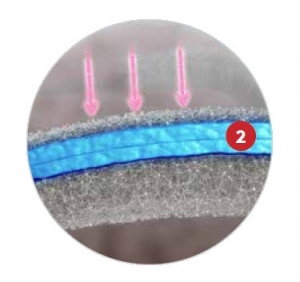
Addressing this clinical challenge, Merit Medical® introduced the Merit WRAPSODY™, a novel endoprosthesis designed with a revolutionary cell-impermeable middle graft layer. With this unique feature, the Merit WRAPSODY Endoprosthesis inhibits transmural cellular migration without the use of drug bonding, helping to prevent obstructions from forming within the endoprosthesis.
To evaluate device performance, Dolmatch et al. published a study 2 in the Journal of Vascular and Interventional Radiology comparing the patency, cellular response, and thrombogenicity of the Merit WRAPSODY with that of a leading ePTFE covered stent. Both Merit WRAPSODY and leading ePTFE covered stent grafts were implanted in the external iliac arteries of 14 adult sheep for 30 (n = 4), 90 (n = 4), and 180 (n = 6) days. Angiographic patency and percent diameter stenosis (%DS) were assessed at termination. Excised stent grafts were fixed and stained for histopathologic analysis, including neointimal coverage (NC) assessment.
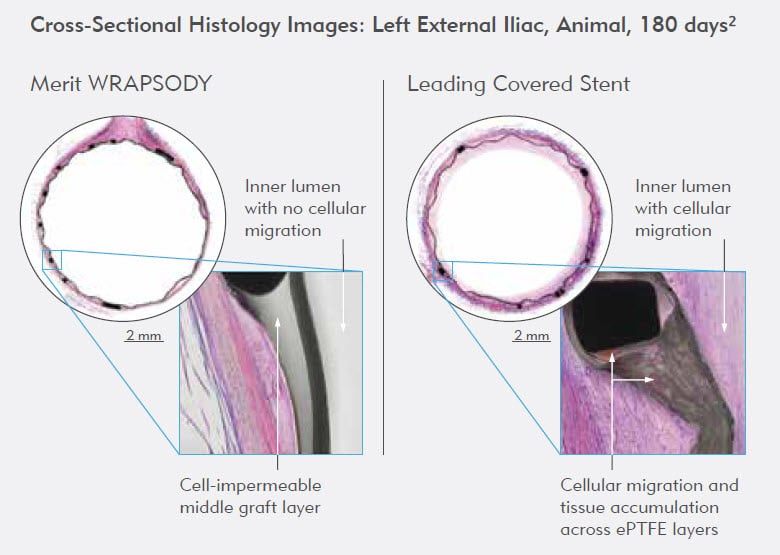
Results showed that the Merit WRAPSODY had lesser mean %DS in comparison to the leading ePTFE covered stent: 4.6% vs. 8.2% (P = .563), 2.0% vs. 10.9% (P = .363), and 2.1% vs. 10.3% (P = .009) at 30, 90, and 180 days, respectively. In addition, median NC scores at 30, 90, and 180 days were significantly lower in middle Merit WRAPSODY sections (P <.05). Proximal and distal Merit WRAPSODY and leading ePTFE covered stent sections exhibited similar median NC scores at all time periods (P >.05).
The authors of the study concluded that the Merit WRAPSODY’s cell-impermeable middle graft layer prevented cellular migration and tissue accumulation across device layers and around nitinol stent struts better than the leading ePTFE covered stent.
In addition to animal models, human trials to investigate the Merit WRAPSODY’s safety and effectiveness are currently underway. The WRAPSODY FIRST, an ongoing clinical trial, will have 6-month and 12-month patency data available at the beginning of next year. Moreover, the WRAPSODY AV Access Efficacy (WAVE) IDE study is expected to start enrolling patients in January 2021. Merit received the CE mark for the Merit WRAPSODY™ from the British Standards Institution (BSI) earlier this year.
Every day Merit works to create solutions to clinical challenges that once seemed impossible. Engineered with dialysis patients in mind, the Merit WRAPSODY Endoprosthesis provides a viable treatment option that preserves functional hemodialysis access.
Discover the Merit WRAPSODY and its many innovative design features by visiting the product page, and contact Customer Service for more information about how you can incorporate the Merit WRAPSODY into your practice.
Related
References
- Rodriguez, Eduardo, et al. 2017. “Hemodialysis Outflow Vein Stenosis.” In Hemodialysis Access Fundamentals and Advanced Management, edited by Sherene Shalhub, Anahita Dua, and Susanna Shin, 257–263. Switzerland: Springer International Publishing.
- Dolmatch, Bart L., John W. Hall, Wayne L. Mower, and Serge D. Rousselle. 2020. “Evaluation of a Novel Spun Polytetrafluoroethylene Stent Graft in an Ovine External Iliac Artery Model.” Journal of Vascular and Interventional Radiology 31: 494–502.
Merit Medical Receives Supplier Horizon Award from Premier Inc.
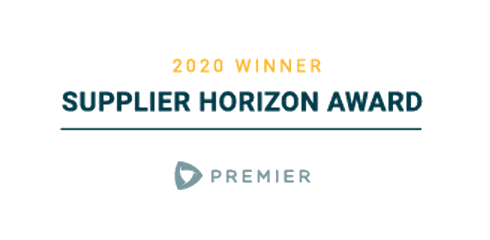
Merit Medical is proud to be a 2020 Recipient of the Supplier Horizon Award, presented by Premier Inc., a leading healthcare improvement company that unites an alliance of more than 4,100 U.S. hospitals and health systems and approximately 200,000 other providers and organizations to transform healthcare.
One of only nine suppliers to receive the award this year, Merit was recognized for its oncology division’s support of Premier members through exceptional local customer service and engagement, value creation through clinical excellence, and commitment to lower costs.
Merit Oncology’s leading technology is SCOUT® Radar Localization, an advanced wire-free radar localization system designed to improve the precision and predictability of marking tumors, biopsy sites, and lymph nodes prior to neoadjuvant therapy and surgery. SCOUT Radar Localization is the wire-free platform that exclusively spans the care continuum from biopsy to surgery.
Used in more than 770 hospitals, October 2020 marked a milestone for SCOUT, as more than 150,000 women have experienced a wire-free localization.
Related News

9 Helpful Tips for Working from Home
In an effort to slow the spread of COVID-19, many companies are asking employees to work from home. Though working remotely can have its perks (comfy clothes, need I say more?), this type of flexibility may make it difficult for some to focus and be productive.
Working from home brings up a host of questions: How do I maintain work-life balance? How can I ensure my productivity is at its best? What aboutavoiding distractions? As work needs differ from person to person, at-home employees are learning how to resolve these issues in ways that fit their individual needs.
Whether you’re one of those work-from-home naturals or you need a bit of help adapting to your new norm, having a toolkit of resources available is always a plus. Here are 9 tips to help you improve your at-home work environment, making it more productive, focused, and enjoyable.
#1 – Create a Schedule and Stick to It
When there’s no literal clock to punch or office building to frequent, you may find it more difficult to adhere to normal working hours. If this is the case, creating guidelines for when to start and stop work can help maintain work-life balance. Setting alarms on your phone or computer can remind you to begin and end your day on time. Utilizing time-tracking apps, like Rescue Time, can aid in knowing when in your day you’re most focused or distracted. Exploring this information may help to structure your workdays in ways that are most productive, helping you to get the most out of your set hours.
#2 – Safeguard Your Time
For those who haven’t worked from home, images of bingeing your favorite episodes and taking long, leisurely lunches may come to mind. However, the opposite is usually more realistic. Working from home may make it hard for many to call it a day because it’s more difficult to “leave” work. To avoid this issue, communicate your work hours with both colleagues and family.
#3 – Build a Routine
Stumbling from the bedroom to your home office might not be the most motivating way to start work. Building a routine that gently starts your day can help. Make a list of your favorite morning-time activities. This could be sipping coffee, stretching on your yoga mat, listening to a podcast, or making a healthy breakfast. Use your list to create a personalized morning-routine map to follow. Adhering to a routine can help to set you up for a more positive start to your workday. If work doesn’t begin for you in the morning, this advice can be applied to any “start” of a workday.
#4 – Schedule Breaks
This is a big one. How many times have you found yourself in the zone, not even realizing that several hours have gone by without taking a break? I applaud you for your focus—but plain and simple, we all need breaks. Fitting regular breaks into your workday has been found to increase productivity, improve mental well-being, boost creativity, and offer more time for healthy habits (like eating a nutritious lunch or snack, standing and stretching, drinking water, etc.). Apps like Time Out can help you schedule thoughtful breaks into your day.
#5 – Designate a Place to Work
This doesn’t have to be a fancy office in a separate wing of your home. It can be as simple as a small desk and back-supportive chair (your posture will thank you), a laptop connected to a larger monitor (again, your eyes will thank you), and a mouse and keyboard. Stock your drawers with paper, pens, highlighters, and whatever you need to move through your day with ease. Find ways to decorate your office that will motivate you. Maybe this means framing an inspirational quote on your wall or posting your goals somewhere you can see them.
#6 – Communicate Regularly
Something as simple as picking up the phone to voice your needs and ideas, and making sure your team knows how to reach you in return, can go a long way to help ensure tasks runs smoothly. Your company may already have virtual communication tools in place. But if not, conferencing apps like Zoom, Microsoft Teams, and Slack are other options that bring team communication to new heights, allowing you to move projects forward by combining the people, discussions, and information needed.
#7 – Don’t Forget to Socialize
Wait, what? Socialize? Yes, socialize. Working from home means there’s no more chatting with people in the breakroom or the elevator. Yet, this type of interaction is important to maintain. Make time every day to check in with your co-workers. This may mean joining a virtual meeting a few minutes early to see how everyone’s weekend went or sending a quick DM to say hi. Doing small things like this can help to bring teams together—even when working apart.
#8 – Stay Active
Working from home in a pandemic means we have to get creative about how we stay active. During work, set a timer that prompts you to stand and stretch. Have a yoga mat nearby as an extra reminder. Take advantage of apps, like this 7-Minute Workout one, that encourage short bursts of daily activity that can easily be done during your breaks. Walking in place during meetings is another way to avoid sitting all day. If you miss exercising after work, try virtually running with friends or an online yoga class.
#9 – Learn to Share Your Space
For those of us who live with family members or roommates, there’s no better time than the present to make clear your work hours. In addition, be proactive about incidences in your day that can interrupt your work flow, such as the arrival of maintenance personnel during an important phone call. Try to schedule these types of appointments outside of work hours or request someone in your household be available to take care of what’s needed.
Working from home takes adjusting, so be kind to yourself as you navigate this new part of your life. Change takes time. However, using every situation as a way to learn about yourself can help you to create your perfect at-home work environment.
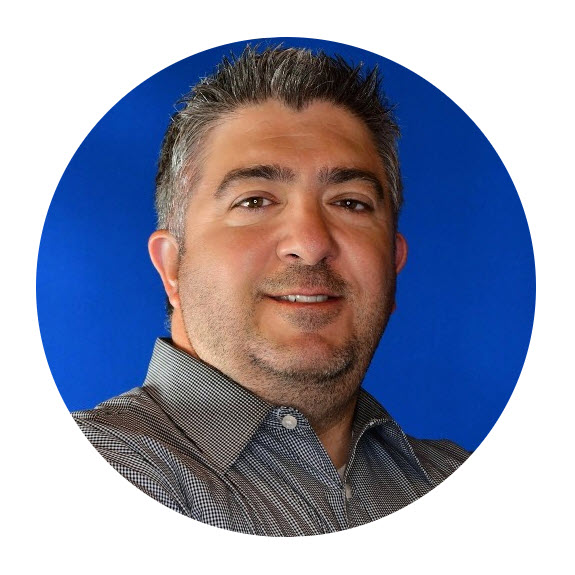
Rick Portrey
Director of Talent Acquisition, US and Global, Merit Medical
Resources
- Duffy, Jill. 2020. “20 Tips for Working from Home.” https://www.pcmag.com/news/get-organized-20-tips-for-working-from-home
- Pollak, Lindsay, and Eileen Coombes. 2020. “23 Essential Tips for Working Remotely.” https://www.inc.com/lindsey-pollak-eileen-coombes/remote-work-home-productivity-communication-self-care-morale-team.html
- Khidekel, Marina. 2020. “How to Stay Active When Working from Home.” https://thriveglobal.com/stories/how-to-stay-active-workout-exercise-remote-working-from-home/
- Wylde, Kaitlyn. 2020. “11 Apps That’ll Make Working from Home Way More Enjoyable.” https://www.bustle.com/p/11-must-have-apps-for-working-from-home-22664725
Our Commitment. Our Promise.

Merit Medical is committed to reducing the burden that cancer places on patients and their loved ones. To further demonstrate this commitment, Merit is partnering with BreastCancer.org, an organization dedicated to educating and empowering people with breast cancer.
Throughout the months of September and October 2020, Merit will donate $1,000 to Breastcancer.org for each SCOUT® console sold worldwide that exceeds monthly goals. Learn more about SCOUT Radar Localization.
Like Merit, BreastCancer.org is committed to the mission of reducing the burden of breast cancer and reaches millions of people each month worldwide, providing much-needed resources and support.

During Breast Cancer Awareness Month and every month, Merit’s promise remains the same—to consistently invest in improving technologies and innovating new platforms that meet patient and physician needs.
Prelude IDeal™ Provides Real Solution to Common Radial Access Challenge
Prelude IDeal™ Provides Real Solution to Common Radial Access Challenge
During radial access procedures, many thin-walled sheath introducers on the market pose the risk of kinking or compressing, either near the access site or inside the radial artery, resulting in wires, catheters, and other devices unable to move through. After years of research, the Merit R&D team built the Prelude IDeal™, a hydrophilic sheath introducer designed to specifically resist kinking and compression while also facilitate smooth device movement and exchange, providing a real solution to this common radial access challenge.
THINNER BUT STRONGER
To combat both kinking and compression, the Merit R&D team envisioned a sheath with a wall that was thinner and stronger than the products physicians currently used.
To achieve this balance, they developed a composite braiding technology to serve as the inner layer of the Prelude IDeal sheath, giving it a 13% thinner wall than the leading thin-walled sheath competitor.1 Unlike other thin-walled sheaths, the braiding of the Prelude IDeal also gives it structural integrity to increase kinking and compression resistance, making it 124% more resistant to sidewall compression and 23% more kink resistant than the leading competitor.1
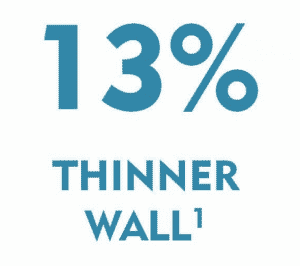
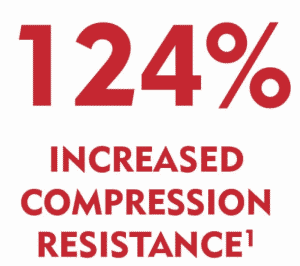
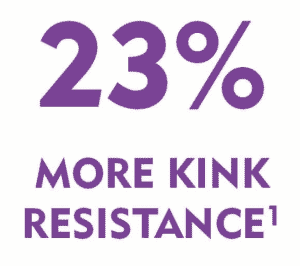
SAME OD, LARGER ID
With a thinner wall, the Prelude IDeal maintains the same sheath outer diameter (OD) as the market leader but larger inner diameter (ID). This increased internal capacity enables smooth wire, catheter, and device manipulation and exchange.

MADE FOR RADIAL
The Prelude IDeal was developed specifically with radial access in mind. Combining a thinner wall with a composite braiding technology enable the Prelude IDeal to maintain structural integrity, protecting the sheath from compression during vessel spasm, a potential side effect of radial artery access.
In addition, the Prelude IDeal’s kink resistance is crucial when implementing the distal radial technique, where the anatomy of the hand can be more tortuous and accessing the vessel at an increased upright angle is necessary. The robust structure of the Prelude IDeal makes it a practical device choice in distal radial procedures.
WITHSTANDS EXTERNAL PRESSURE
A typical thin-walled sheath may collapse, for example, when it encounters a narrowing of the vessel, preventing catheters and wires from passing through.
With structural integrity provided by its braided composite structure, the Prelude IDeal withstands the natural bends and curves of the artery and aids in straightening the vessel, allowing catheter manipulation and torque without sheath compression.
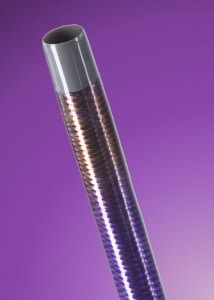
DISCOVER THE PELUDE IDEAL
The Prelude IDeal Hydrophilic Sheath Introducer has become the tool of choice for radial and distal radial access procedures around the globe. Its story is much like Merit’s overall goal—to listen to the needs of physicians and innovate ways to improve patient care.
Explore all the Prelude IDeal has to offer by visiting its product page or contacting the Merit Customer Support Center.
REFERENCES
- 6F Data on File. Merit assumes no responsibility to update test data.
Now Available in the US, Surfacer® System Provides Treatment Option for Venous Obstructions
Merit Medical® is committed to offering products that provide patients with better dialysis access options. The newest of these innovations is the Surfacer® Inside-Out® Access Catheter System, a unique device designed to obtain right-sided central venous access in patients with venous obstructions. The Surfacer System received FDA De Novo classification in the US earlier this year and has been CE marked in Europe since 2016.
The current clinical approach when treating dialysis patients with chronically occluded central veins is to use another vein if a subsequent central venous catheter is needed. Failed venous access attempts may prevent permanent arteriovenous access, increasing patient morbidity and the overall cost of care.1

Designed to gain central venous access, the Surfacer System works by inserting the device through the right femoral vein and navigating it up through the patient’s venous system with an exit point in the right internal jugular vein, the optimal location for placing a central venous catheter. Watch how the Surfacer System works.
This proprietary “Inside-Out” approach supports the achievement of permanent arteriovenous access, which reduces hemodialysis provider cost and patient downtime by decreasing catheter-related morbidity and complications.1
Additional clinical benefits of using the Surfacer System were seen in its first-in-human study.2 Results showed that 100% of patients experienced successful central venous access placement, and 100% of patients maintained central venous access patency through long-term follow up. No device-related adverse events were reported at short- or long-term follow up. To learn more about the Surfacer System’s first-in-human study, view the article published in Endovascular Today.

In May of this year, the Surfacer System’s first US-based commercial cases were completed at Santa Clara Valley Medical Center in San Jose, California, one of several clinical sites for the US investigational device exemption (IDE) study, which led to FDA De Novo status. Ehab Sorial, MD, and Ajit Nair, MD, performed the procedures in two hemodialysis patients with central venous obstructions, one of which had limited access options.
“The Surfacer System provides us with a safe and effective option for obtaining right-sided central venous access in patients with venous obstructions, enabling us to preserve secondary central veins and avoid alternative access procedures, which are not as effective and have a higher risk of complications,” explained Drs. Sorial and Nair in a press release. Read the full press release here.
Merit currently distributes the Surfacer System in North America and Europe. With the device’s recent launch in the US, Merit is proud to play an integral role in providing physicians with life-saving technologies for their patients around the world.
Discover the Surfacer Inside-Out Access Catheter System and explore Merit’s entire portfolio of renal therapies and accessories.
All trademarks are property of their respective owners.
REFERENCES
- Data on file at Bluegrass Vascular Technologies, Inc.
- Ebner, A., S. Gallo, C. Cetraro, J. Gurley, and L. Minarsch. 2013. “Inside-Out Upper Body Venous Access: The First-in-Human Experiences with a novel Approach Using the Surfacer Inside-Out Access Catheter System.” Endovascular Today. June 2013. https://evtoday.com/articles/2013-june/inside-out-upper-body-venous-access.
Merit Employees Describe Benefits of Telecommuting
The COVID-19 pandemic has changed our lives in many ways, and we are all in the same boat as we try and navigate the “new normal.” One major adjustment for many is working from home. While some love it, others aren’t so sure.
However, telecommuting may be something that’s here to stay, even in a post-COVID-19 world. To help you transition, we’ve created a list of potential benefits that we found our employees appreciate as they work from home.
Increased Productivity

It may seem counterintuitive, but working from home actually increases productivity. According to one study published by the Stanford Graduate School of Business, at-home employees of a Chinese travel agency experienced a 13% performance increase versus their colleagues who worked in the office.

Enhanced Communication
With the advent of numerous communication platforms, interacting with colleagues couldn’t be easier.
“We’ve experienced better interaction in our department using Microsoft® Teams,” explains Vicki Biehn, Merit Medical’s Vice President of Commercial Operations. “The chat feature is helpful if someone has a quick question, or we can all jump on an audio or video call to discuss specific projects. It’s more efficient this way.”
Greater Independence
This can be a huge benefit for people who live with anxiety, who are introverted, or those who feel uncomfortable working in an office setting. Telecommuting can make it easier to get the job done with less supervision or micromanaging. In the relaxed home environment, employees are able to move through the day without feeling like someone is looking over their shoulder.
Work-Life Balance

Everyone appreciates a career that provides work-life balance. However, it may be even more important at this time for people who have a family.
“I’ve found that employees with school-age children really appreciate the option of working from home,” Ms. Biehn says. “Right now, many parents have the option of sending their children to school or participating in virtual learning. Virtual learning only works if a parent is home with the child. Telecommuting makes this possible.”
Less Commuting
Probably one of the most positive changes working from home brings is no longer having to commute long distances to the office. This means no more sitting in traffic or needing to wake up hours in advance to beat the morning rush. The average one-way commute time for Americans reached 27.1 minutes in 2018. Less time on the road can translate into more time doing the things you love, spending time with family, or focusing on self-care.
Cleaner Air
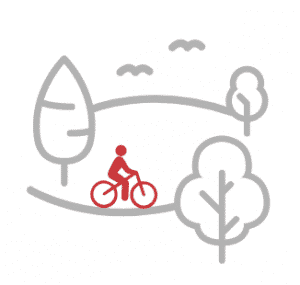
A recent article in Scientific American discussed how switching to telecommuting, even part time after the pandemic, could help decrease air pollution and fight climate change by having fewer cars on the road. It’s estimated that if employees in the U.S. who held telecommuting jobs worked remotely half of the time, this reduction in commuting could decrease greenhouse gas emissions by more than 54 million tons each year.

Better Self Care
Many employees find they live healthier lifestyles when working from home.
“I personally find it easier to eat healthy,” Ms. Biehn says. “Planning ahead is simpler, and it’s calmer at home. Having my kitchen and preferred foods right there enables me to stay in my routine, allowing me to focus more on my work.”

Personalized Workstations
If working in a cubicle was never for you, now is a great opportunity to personalize your workspace at home. This means you can invest in that standing desk you’ve always wanted (much better for you than sitting all day!), purchase a comfy, back-supporting chair for the times you do sit, position yourself by a bright window for natural light, and place plants and colorful trinkets around to make it your own.
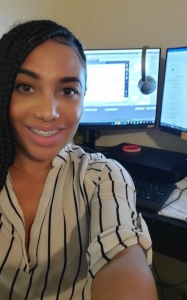
Improved Customer Service
This may be specific to certain industries, but the ability to provide better customer service is a potential significant advantage when working from home. Virtual programs allow what was initially done in person—such as workshops, training courses, and in-services—to now be done online.
“In my department, we have software that better enables us to monitor who’s in queue for phone calls and how many phone calls our employees are taking,” Ms. Biehn explains. “This not only helps us provide exceptional customer service, but it also allows us to better support our team in their work.”
Money in the Bank
Remember all the time gained by not commuting to the office? This can also translate into money saved. Commuting half the time could save between $2,000 and $7,000 in transportation and work-related costs. Those who care for family would be able to save on after-school and eldercare. Many at-home workers would also qualify for home office tax breaks.
Time Efficiency
We’ve all been there. You have a meeting on the books, and yet you’ve been waiting outside your colleague’s office for fifteen minutes. It happens. Everyone’s busy, but that’s also time wasted.
“Being able to wait at your home office for a meeting to start has been much more efficient. Work output has been better,” Ms. Biehn says. “Also, if people are running late, they can jump into a virtual meeting without disrupting the flow.”
Less Illness
COVID-19 aside, reducing contact with others can help you and your family avoid getting sick with other illnesses, such as cold and flu.
Improved Job Satisfaction
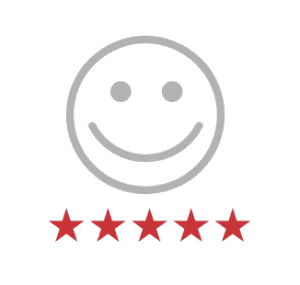
One of the most important advantages of telecommuting, which should not be overlooked, is how telecommuting makes you feel about the work you do. The same aforementioned Stanford Graduate School of Business study that found a correlation between working at home and increased productivity also found that home workers reported improved work satisfaction.
“I’ve had a number of employees say they enjoy their work more and are happier telecommuting,” Ms. Biehn explains. “This is a meaningful piece of information for employers and department leaders to know because employees are the heart of every company.”
Three-Fraction SAVI Brachytherapy: Reducing Patient Interactions During COVID-19
This is a transformative time in breast cancer treatment with advances in neoadjuvant chemotherapy, wire-free tumor localization, and additional tools for post-surgical radiation treatment. During the past two years, the TRI-fraction Radiotherapy Utilized to Minimize Patient Hospital Trips, or the TRIUMPH-T Trial, for 2-day brachytherapy has helped redefine how Accelerated Partial Breast Irradiation (APBI) can be delivered.
APBI, has historically been performed in 2 fractions a day for five days. The clinical benefits of targeted radiation delivered by brachytherapy include reduced radiation exposure to healthy tissue, improved cosmesis, and fewer long-term side effects.
The TRIUMPH-T trial demonstrated the potential benefits of treating a patient with brachytherapy in only two days. Some of the benefits outlined in the trial include a reduction in the amount of radiation delivered to normal breast and organ tissue, the elimination of delays in systemic/local therapy, and a reduction of treatment time. All while preserving excellent cosmesis and local recurrence rates.
These benefits are even more valuable during COVID-19, where limited patient interactions and the conservation of PPE are increasingly important.
In contrast to hypo-fractionated External Beam Radiation Therapy (EBRT) which uses 16 Fractions, the 2-day TRIUMPH-T fractionation with a total of 3 fractions patient interactions will be substantially reduced patient contact to about 1/3 of the patient contact interactions as EBRT.
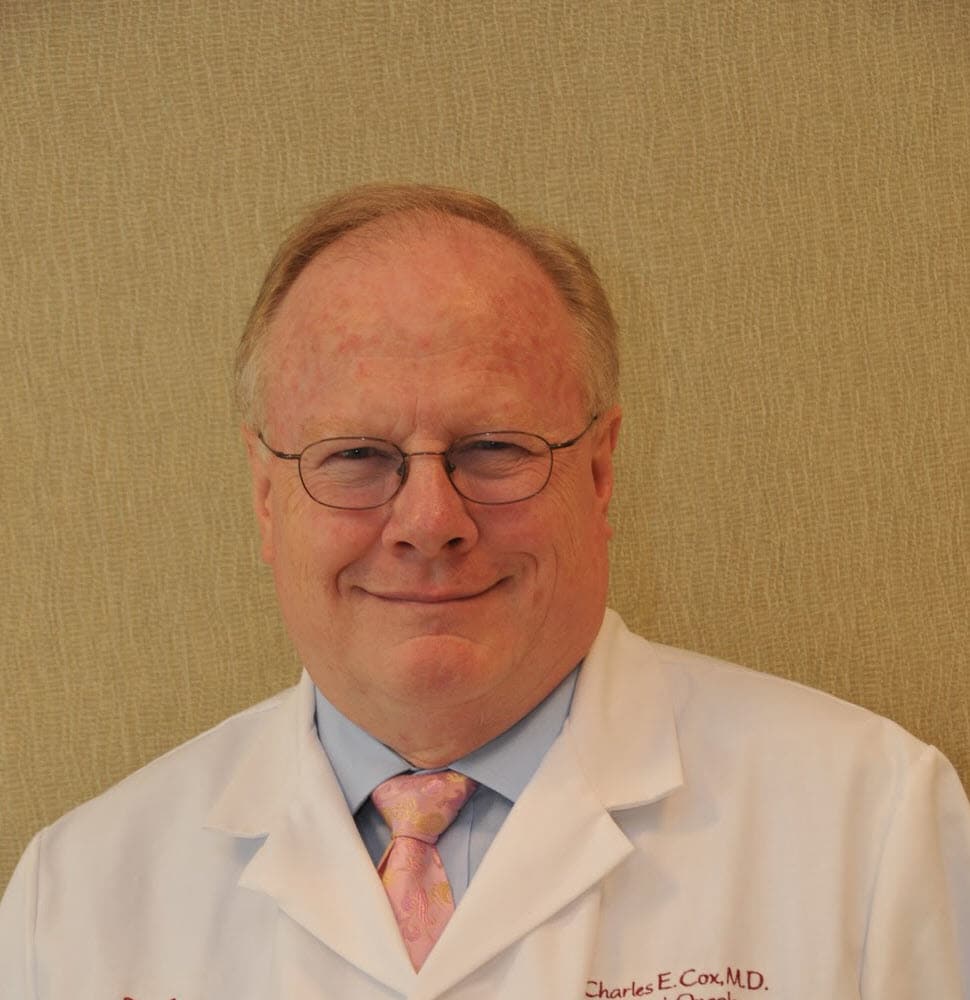
Charles E. Cox, MD, FACS
Endowed Chair, College of Medicine Surgery
USF Health, Tampa, FL
“The combination of the reported excellence of the outcomes from the patients treated with this protocol along with the abbreviated schedule make it a more acceptable method with less exposure to both the patients and the medical providers. During COVID-19, whenever we can limit interactions and not compromise outcomes or patient satisfaction, we are inclined to do so. Our patients have welcomed this abbreviated treatment option.”
*Reduced fractionation schedule from 6 weeks, not including boost: conservative estimate in number of interactions.
References
- Khan, Atif J., Peter Y. Chen, Catheryn Yashar, Matthew M. Poppe, Linna Li, Zeinab Abou Yehia, and Frank A. Vicini et al. “Three-Fraction Accelerated Partial Breast Irradiation (APBI) Delivered With Brachytherapy Applicators Is Feasible And Safe: First Results From The TRIUMPH-T Trial”. International Journal Of Radiation Oncology, Biology, Physics 104, no. 1 (2019): 67-74. doi:10.1016/j.ijrobp.2018.12.050.
Information courtesy of Catheryn M. Yashar, MD, and Dan Scanderbeg, PhD. TRIUMPH-T APBI with SAVI. 03 Apr 2020. La Jolla, CA. Webinar presentation archived at https://meritlegacy.decort.co/ three-fraction-apbi-with-savi-webinar-apr-3-2020/.
Top 10 COVID-19 Precautions Merit Takes to Keep Manufacturing Employees Safe
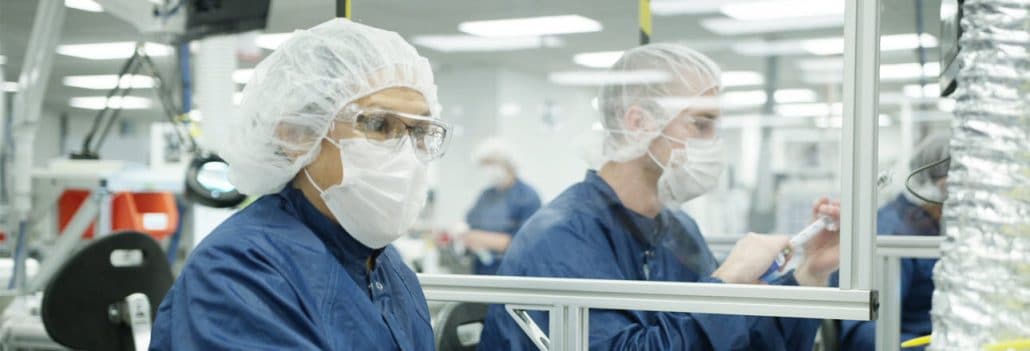
Manufacturing facilities have become hotspots for COVID-19, with outbreaks often difficult to contain. To protect manufacturing employees, Merit Medical implements a checklist of preventative measures. These precautions have resulted in a current infection rate of 1.5 percent.1 Not only have these actions helped to slow the spread, they have also made it possible to continue to supply healthcare professionals and patients with the life-saving medical devices and products needed most.

1: MANDATORY MASKS ON CAMPUS
Both the Centers for Disease Control and Prevention (CDC) and the World Health Organization (WHO) now recommend wearing cloth masks for the general public. Research2 has also shown that countries with cultural norms or government policies that favor mask-wearing had lower coronavirus death rates. Following this guidance, Merit has made it mandatory for employees to wear masks while at work.

2: SOCIAL DISTANCING
We now know that COVID-19 can be spread from one person to another through respiratory droplets.3 Given this information, Merit believes social distancing is one of the most effective tools that can slow the spread of COVID-19. To help keep people separated during this time, the company has implemented social distancing at each of its facilities by placing visible reminder stickers on the floor, reorganizing café lines and seating, spreading apart outdoor eating areas, and—where applicable—working from home.

3: CASHLESS CAFÉS
According to the CDC,3 it may be possible to catch COVID-19 by touching a surface or object that has the virus on it and then touching the mouth, nose, or eyes. Although this is not the main way the virus spreads and more research is needed, Merit has implemented a cashless café at its global headquarters in Utah to help minimize the exchange of cash between people, potentially helping to reduce the spread of COVID-19.

4: FREQUENT HANDWASHING
As mentioned, respiratory viruses like COVID-19 are spread when droplets containing the virus enter the body through, for example, the eyes or nose. Commonly, this happens by way of your hands. Merit encourages employees to frequently wash hands for at least 20 seconds to eliminate traces of the virus.


6: LIMITED BUSINESS TRAVEL
The CDC has cautioned5 that travel increases the chances of getting and spreading COVID-19. Following this guidance, Merit has put extensive procedures in place for business travel.

7: RETURN-TO-WORK CHECKLIST
Any employees who have tested positive for COVID-19 must go through a return-to-work checklist and are screened by me to ensure there is no current illness. An appropriate time must also pass before returning to work.

8: “IF FEELING ILL, STAY HOME”
To minimize the potential spread of COVID-19 at Merit facilities, the company continues to advertise that employees who are not feeling well not come to work and to immediately contact their healthcare provider.

9: HEIGHTENED CLEANING EFFORTS
Thanks to a hardworking janitorial staff, Merit continues to keep all facilities clean, with special attention given to disinfecting frequently touched surfaces during this time.

10: COVID-19 WEEKLY NEWSLETTERS
Every other week I create a COVID-19 newsletter and send it out via email to all Merit employees. These newsletters answer common COVID-19 questions, include the latest research and recommendations, and offer tips to help keep employees healthy.
We all have to do our part to slow the spread of COVID-19. By implementing these precautions, we are helping to keep our employees, and by extension our communities, safe during the pandemic.

Merit Medical Chief Wellness Officer
REFERENCES
- Merit Medical. 2020. “COVID-19 Response & Resources.” Last modified August 10, 2020. https://meritlegacy.decort.co/covid-19-response-resource-page/.
- Leffler, Christopher, Edsel Ing, Joseph Lykins, Matthew C Hogan, Craig McKeown, and Andrzej Grzybowski. 2020. “Association of Country-wide Coronavirus Mortality with Demographics, Testing, Lockdowns, and Public Wearing of Masks (Update June 15, 2020).”
- Centers for Disease Control and Prevention. 2020. “How COVID-19 Spreads.” Last modified June 16, 2020. https://www.cdc.gov/coronavirus/2019-ncov/prevent-getting-sick/how-covid-spreads.html.
- Johns Hopkins Medicine. 2020. “Coronavirus Symptoms: Frequently Asked Questions.” Last modified June 26, 2020. https://www.hopkinsmedicine.org/health/conditions-and-diseases/coronavirus/coronavirus-symptoms-frequently-asked-questions.
- Centers for Disease Control and Prevention. 2020. “Travel: Frequently Asked Questions and Answers.” Last modified May 28, 2020. https://www.cdc.gov/coronavirus/2019-ncov/travelers/faqs.html.
Merit Medical Launches GO2WIRE™ Steerable Guide Wire System

New Steerable Guide Wire Offers Physicians a Number of Desirable Features, Making it the New “Go-To” Wire for Diagnostic and Interventional Procedures.
Merit Medical® is proud to announce the official market launch of the GO2WIRE™ Steerable Guide Wire System, a wire designed to facilitate the placement and exchange of devices during peripheral diagnostic and interventional procedures. Built with a number of key features, the GO2WIRE helps physicians confidently navigate the most challenging vasculature.
AVAILABLE IN THREE TIP CONFIGURATIONS

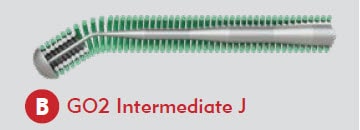

Available in three tip configurations—Floppy Straight, Intermediate J, and Standard Straight—the GO2WIRE offers both support and flexibility when accessing complex anatomy. Engineered with Straight Linear Torque Steel Core Wire technology, data1 shows the GO2WIRE has a 40% tip response improvement over the leading competitor. The GO2WIRE’s distal tip is reshapable, providing physicians with the ability to modify the wire tip to meet specific anatomical needs. Enhanced with platinum, the tip provides excellent visibility under fluoroscopy.
TWO BODY STYLES
To further help physicians traverse tortuous vessels, the GO2WIRE is also available in two body styles—non-extendable and extendable—with the largest range of length options offered in the market. As an advocate of radial access, Merit designed the GO2WIRE with an exclusive 210 cm length configuration specifically designed for radial access procedures. In addition, the GO2WIRE provides an optional 155 cm extension device with smooth threads, a modification that helps deliver rapid conversion to longer wire lengths for seamless device and catheter exchanges. The GO2WIRE also has a proprietary PTFE pre-coating to help reduce friction and improve trackability.
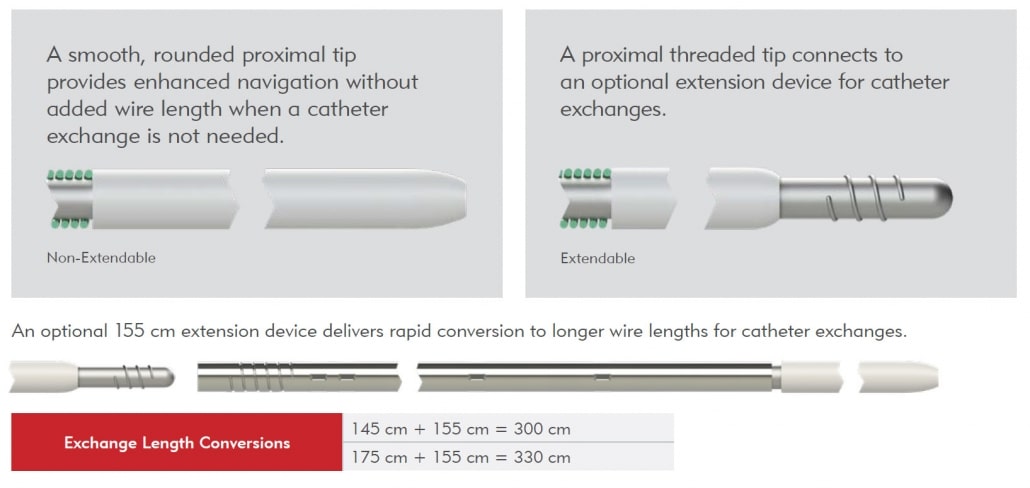
Explore the GO2WIRE Steerable Guide Wire System.
1. Data on file.
How SCOUT® Impacted my Breast Cancer Journey
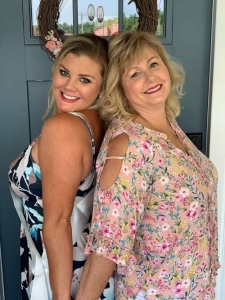
As told by Faith Smith
When my biopsy came back positive for breast cancer and I was told I needed a lumpectomy, my daughter was adamant that I seek a second opinion from a breast surgeon who would use SCOUT for localizing my tumor. She explained to me that SCOUT is a more comfortable option because I wouldn’t have a wire sticking out of my breast, and would give my surgeon more accurate localization to remove my tumor.
I always thought that the treatment for breast cancer was basically the same anywhere you went, but after I had a consultation with Lori Gentile, MD at Novant Health (Huntsville, NC) it became very apparent that was not the case.
Dr. Gentile explained exactly what would happen and how they would localize my tumor using SCOUT wire-free technology. It was a very different experience from my first consultation where the localization method would have been a wire. Learning about the wire procedure made me a bit uneasy thinking ‘How would they find my very small tumor during surgery?’, but it was a big relief to know that the SCOUT system would give real-time guidance and Dr. Gentile would know exactly where my tumor was with incredible accuracy.
The placement of the SCOUT Reflector happened several days before my surgery and it was simple and easy. I did not feel the insertion, just the mammography compression. At first, I didn’t understand why the Reflector was inserted on a different day from surgery, but Dr. Gentile explained that it eliminates any radiology and surgery scheduling issues. I ended up really appreciating having the two procedures on separate days, since being a breast cancer patient and having so many things going on can be overwhelming — I found that breaking it down into smaller tasks helped. When the day of my surgery arrived I was naturally anxious, but with my Reflector in place my surgery started exactly on time –— no delays.
The results of my surgery are amazing! Since I had a SCOUT Reflector, Dr. Gentile had more options in deciding where to make the surgical incision and she was able use an old scar. My breast looks exactly the same. You can’t tell where she made the incision or that I even had surgery. To some people that may seem like a small thing, but to me it is huge. Cancer rocks you to the core. “You have cancer” are such hard words to hear, and anything that keeps your world the same is monumentally important.
When I got the call that both my surgical margins and lymph nodes were clear something washed over me — a sense of calm, relief, and a readiness to face the next part of this journey. I am so thankful that throughout my journey I have felt very cared for and very blessed.
I would want other women going through this to know that breast cancer surgery is not the same everywhere. You need to research your options and look for physicians and facilities offering the newest technologies so that you can find the treatment option that is right for you.
Name: Faith Smith
Age: 60
Facility: Novant Health System, Huntsville, NC
Surgeon: Lori Gentile, MD
Please note: This information is not intended nor recommended as a substitute for medical advice, diagnosis or treatment. Always seek the advice of a qualified physician regarding any medical questions or conditions.

